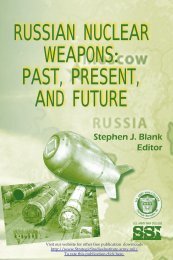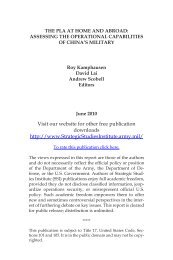The United States and China in Power Transition - Strategic Studies ...
The United States and China in Power Transition - Strategic Studies ...
The United States and China in Power Transition - Strategic Studies ...
Create successful ePaper yourself
Turn your PDF publications into a flip-book with our unique Google optimized e-Paper software.
<strong>in</strong>stance) <strong>and</strong> came up with documented evidence<br />
to support their views. <strong>The</strong>y found that<br />
the <strong>United</strong> <strong>States</strong> was actively <strong>in</strong>volved <strong>in</strong><br />
help<strong>in</strong>g Tibet to establish <strong>in</strong>dependent nationhood<br />
<strong>in</strong> the late 1940s <strong>and</strong> early 1950s. <strong>The</strong>y<br />
also found that the <strong>United</strong> <strong>States</strong> cont<strong>in</strong>ued<br />
to encourage Tibetans to pursue the course of<br />
<strong>in</strong>dependence throughout the 1950s, provided<br />
Tibetans with weapons <strong>and</strong> tra<strong>in</strong>ed Tibetan<br />
fighters, <strong>and</strong> eventually helped the Dalai Lama<br />
to flee from <strong>Ch<strong>in</strong>a</strong> <strong>in</strong> 1959. 186<br />
• <strong>The</strong> Ch<strong>in</strong>ese analyses are further supported by<br />
American writers reveal<strong>in</strong>g U.S. <strong>in</strong>volvement<br />
<strong>in</strong> the Tibetan affairs. 187<br />
• In addition, Ch<strong>in</strong>ese analysts have also documented<br />
U.S. congressional efforts to support<br />
the Tibet <strong>in</strong>dependence movement. 188<br />
• <strong>The</strong> Ch<strong>in</strong>ese all hold that s<strong>in</strong>ce the end of the<br />
Cold War, <strong>and</strong> especially s<strong>in</strong>ce <strong>Ch<strong>in</strong>a</strong> showed<br />
signs of its ris<strong>in</strong>g, U.S. policy on Tibet has become<br />
part of the U.S. efforts to slow down or<br />
even derail <strong>Ch<strong>in</strong>a</strong>’s development. <strong>The</strong> Ch<strong>in</strong>ese<br />
argue that the <strong>United</strong> <strong>States</strong> does not really care<br />
about human rights <strong>and</strong> economic wellbe<strong>in</strong>g <strong>in</strong><br />
Tibet; U.S. policy on Tibet has to serve overall<br />
U.S. <strong>in</strong>terest regard<strong>in</strong>g <strong>Ch<strong>in</strong>a</strong>; U.S. concerns<br />
about political, religious, <strong>and</strong> ethnic rights <strong>in</strong><br />
Tibet are only smokescreens for the <strong>United</strong><br />
<strong>States</strong> to leverage <strong>in</strong>fluence over changes <strong>in</strong><br />
<strong>Ch<strong>in</strong>a</strong>. 189<br />
In all fairness, one can see that the Dalai Lama is<br />
reconciliatory. Indeed, <strong>in</strong> a note presented to the Ch<strong>in</strong>ese<br />
government by the Dalai Lama’s dialogue representatives<br />
<strong>in</strong> their latest round of talks <strong>in</strong> February<br />
2010, the Dalai Lama has gone so far as to reaffirm un-<br />
166

















